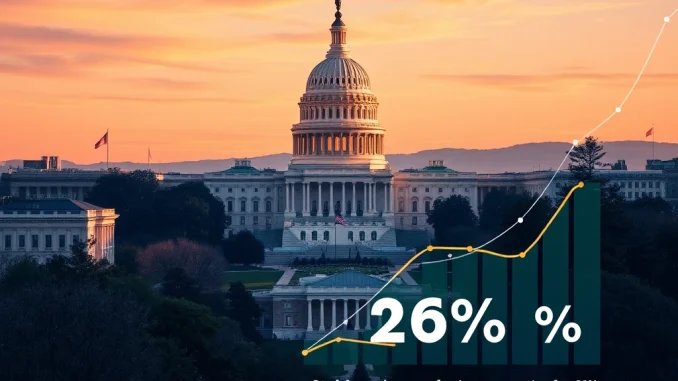
The world of cryptocurrency is constantly evolving, and with that evolution comes increased scrutiny from regulators. A significant development on this front is the growing likelihood of comprehensive stablecoin regulation in the United States. According to data from Polymarket, a popular decentralized prediction market platform, traders are currently placing a high probability – specifically an 89% chance – on a key piece of legislation becoming law.
What Does the Polymarket Prediction Signal?
Polymarket allows users to bet on the outcome of future events, ranging from politics to finance to crypto. The prices on Polymarket’s markets reflect the collective beliefs of its users, effectively acting as a real-time indicator of perceived probabilities. The current Polymarket prediction of an 89% chance for the stablecoin regulation bill to pass indicates strong market confidence that this legislative effort is on track to succeed.
Why is this prediction noteworthy? Prediction markets like Polymarket can often provide insights into market sentiment and expectations that traditional polls or analyses might miss. While not a guarantee, such a high percentage suggests that participants believe the remaining hurdles for the bill are relatively minor.
Understanding the GENIUS Act
The legislation in question is referred to in reports as the GENIUS Act. This bill aims to establish a clear regulatory framework for stablecoins operating within the United States. Based on the information available, the bill includes several key provisions:
- Licensing Requirements: Imposing mandatory licensing for entities that issue stablecoins. This means issuers would need formal approval from regulators to operate.
- 100% Reserve Requirements: Mandating that stablecoin issuers hold reserves equal to 100% of the value of the stablecoins they have issued. These reserves are intended to ensure that stablecoins can always be redeemed at their pegged value (e.g., $1 for a USD-pegged stablecoin).
- Audit Requirements: Requiring regular audits for larger stablecoin issuers. Specifically, issuers with a market capitalization of $50 billion or more would face stringent audit mandates to verify their reserve holdings and financial stability.
- Regulations for Foreign Issuers: Establishing rules that apply to stablecoin issuers based outside the U.S. but offering services to U.S. customers, aiming to create a level playing field and prevent regulatory arbitrage.
These measures are designed to enhance consumer protection, ensure financial stability, and integrate stablecoins more formally into the existing financial system.
What’s Next for the US Crypto Law?
The path to becoming a full-fledged US crypto law involves navigating the American legislative process. According to reports, the GENIUS Act has already cleared a significant hurdle by passing the final vote in the U.S. Senate. This is a major step forward for the bill.
However, the process is not yet complete. The bill must still pass the House of Representatives and then receive the signature of the President. The mention of President Donald Trump’s signature in the source material indicates the specific political context surrounding the reported progress of this bill.
The high probability shown on Polymarket suggests that traders anticipate successful votes in the House and subsequent presidential approval, potentially making this bill one of the most impactful pieces of stablecoin regulation to date.
Potential Implications of the Stablecoin Bill
If the stablecoin bill passes and becomes law, it could have profound implications for the cryptocurrency ecosystem, particularly for stablecoin issuers and users in the United States. For issuers, it would mean adapting to stringent new compliance requirements, including potentially restructuring reserve management and undergoing regular audits.
The legislation is also expected to set a precedent, potentially becoming a benchmark for how other countries or regions approach stablecoin regulation. For users, increased regulation could bring greater confidence and stability to the stablecoin market, potentially encouraging wider adoption for payments and transfers, though compliance costs for issuers might indirectly affect user experience or fees.
Why is Stablecoin Regulation Crucial?
The push for stablecoin regulation stems from the growing importance of stablecoins within the digital asset landscape. Stablecoins serve as a bridge between traditional fiat currencies and volatile cryptocurrencies, facilitating trading, lending, and payments.
However, their stability relies heavily on the reserves held by issuers. Past incidents in the crypto market have highlighted the risks associated with poorly managed or opaque reserves, which can lead to stablecoins losing their peg and causing significant losses for users and potentially impacting broader financial stability. Regulation aims to mitigate these risks by ensuring transparency, adequate reserves, and robust oversight.
Conclusion: A New Era for Stablecoins?
The strong Polymarket prediction of an 89% likelihood for the GENIUS Act to pass signals that significant stablecoin regulation in the U.S. is likely on the horizon. This potential US crypto law, if enacted, will introduce clear rules for stablecoin issuers, focusing on licensing, reserves, and audits. While the legislative process still requires steps in the House and presidential approval, the high probability suggests these hurdles are expected to be cleared. The passage of this stablecoin bill could usher in a new era for stablecoins, potentially increasing their legitimacy and adoption while imposing stricter compliance burdens on issuers. Market participants should pay close attention as this crucial piece of legislation moves towards becoming law.



